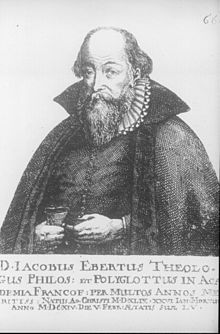Du Friedefürst, Herr Jesu Christ, BWV 116
| Du Friedefürst, Herr Jesu Christ | |
|---|---|
| BWV 116 | |
| Chorale cantata by J. S. Bach | |

Jakob Ebert, the author of the hymn
|
|
| Occasion | 25th Sunday after Trinity |
| Performed | 26 November 1724: Leipzig |
| Movements | 6 |
| Cantata text | anonymous |
| Chorale | "Du Friedefürst, Herr Jesu Christ" by Jakob Ebert |
| Vocal | SATB choir and solo |
| Instrumental |
|
Du Friedefürst, Herr Jesu Christ (You Prince of Peace, Lord Jesus Christ),BWV 116, is a church cantata written by Johann Sebastian Bach in 1724 in Leipzig for the 25th Sunday after Trinity. He led the first performance it on 26 November 1724, concluding the liturgical year of 1724.
The cantata is based upon Jakob Ebert's hymn "Du Friedefürst, Herr Jesu Christ". It matches the Sunday's prescribed gospel reading, the Tribulation from the Gospel of Matthew, in a general way. The hymn's first and last stanza are used unchanged in both text and tune: the former is set as a chorale fantasia, the latter as a four-part closing chorale. An unknown librettist paraphrased the inner stanzas as alternating arias and recitatives. Bach scored the cantata for four vocal soloists (soprano, alto, tenor, bass), a four-part choir and a Baroque instrumental ensemble of natural horn, enforcing the soprano in the hymn tune, two oboes d'amore, strings and basso continuo.
Bach wrote the cantata in 1724 for the 25th Sunday after Trinity as part of his second annual cycle of mostly chorale cantatas. The prescribed readings for the Sunday were from the First Epistle to the Thessalonians, the coming of the Lord (), and from the Gospel of Matthew, the Tribulation (). The cantata text of an unknown author is based exclusively on Jakob Ebert's hymn in seven stanzas (1601). The librettist of Bach's chorale cantata cycle is not known,but Bach scholar Christoph Wolff notes that "he must have worked closely with Bach" and names as "the most likely candidate" Andreas Stöbel, a co-rector of the Thomasschule. The first and last stanza in their original wording are movements 1 and 6 of the cantata, stanzas 2 to 4 were transformed to movements 2 to 4 of the cantata, and stanzass 5 and 6 were rephrased for movement 5. The hymn is in a general way related to the gospel.
...
Wikipedia
